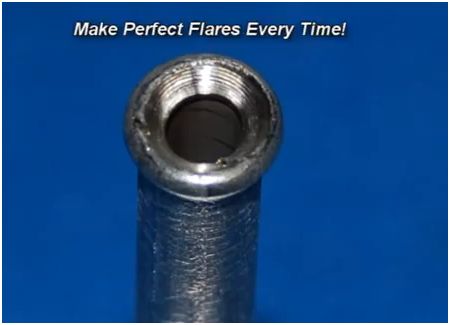Specialty Tools for Double Flaring & Bending Brake Lines
March 23, 2012 8:15 am Brake Bleeding, brakes, Calvan ToolsAbove is a flare made easy by the Calvan 164.
© DenLorsTools.com Summary: Question from a blog reader answered by a master auto technician regarding tools and advice for installing replacement brake lines.
Question – I need to replace some brake lines on my truck and I am new to flaring brake lines. I find the Calvan 164 flaring tool interesting but can find little information about it. Do you have any feedback from users of this tool, positive or negative? Or would I be better off spending more and getting a good quality traditional bar type flaring tool? I will only be doing 3/16 and 1/4 in. flares and only want to buy one flaring tool. Any input is greatly appreciated. Thank you, J. Fraley.
Answer – The Calvan 164 tool is fairly new and I’ve never used that type of flaring tool. We actually have the demonstration video on the product descriptions. See them here – Calvan Metric 154 and the Calvan SAE 164. I have only used the conventional style flaring tools but I can see how the Calvan style will hold up better with less slipping.
You may also get by without flaring the new lines since they are available pre-flared with nuts in different lengths that can be put together with threaded unions. Excess lengths can sometimes be coiled to reduce over-all length if they are too long. If using a flare kit, the exact desired length can be obtained. This would also allow for a much more professional appearing finished job with less chance of unwanted contact with surrounding components.
Important things to know when replacing brake lines:
Avoid kinking brake lines by using a tubing bender (TP14316, see video). If the proper tool is not available, try bending the brake line by pushing with both hands over a pipe. Of course the tool works much easier.
1. NEVER use compression fittings. Unions which accept lines that are properly flared are acceptable.
2. Brake lines use DOUBLE flares not just single. This means the end is double inward which provides more strength.
3. Take into consideration that if the lines get rubbed or are allowed to vibrate excessively they will leak over time. Chafed or rubbed through lines are a leading cause of brake line leaks second only to rust. Up and down suspension movement should be considered. Also, route lines and secure them the same way as original lines were to help prevent issues.
5. Avoid allowing the master cylinder to run empty if possible. This will make bleeding the brakes easier. See our bleeding master cylinder article if needed.
6. After bleeding the brakes (master cylinder and bleeder screws) – leak check the lines. Don’t force bleeder screws they may break. If they are rusted tight – see our Rusted Bleeder Screws article for tips. Water is the best choice for cleaning excess brake fluid, brake cleaner is toxic and not necessary unless dealing with grease/oil. Caution: Brake fluid will ruin painted surfaces!

JP :
Date: November 22, 2012 @ 9:59 am
I have the Calvan 164 as a Bluepoint in-line flaring tool. Brilliant design similar to an existing Kent-Moore design I also use. Consistent & precise flares. Less fuss & more accurate than bar type tools. I find even better than pricey hydra-flare tool. Very compact but solid for flaring right on the vehicle or also in a vise. Hard to go wrong with this tool.